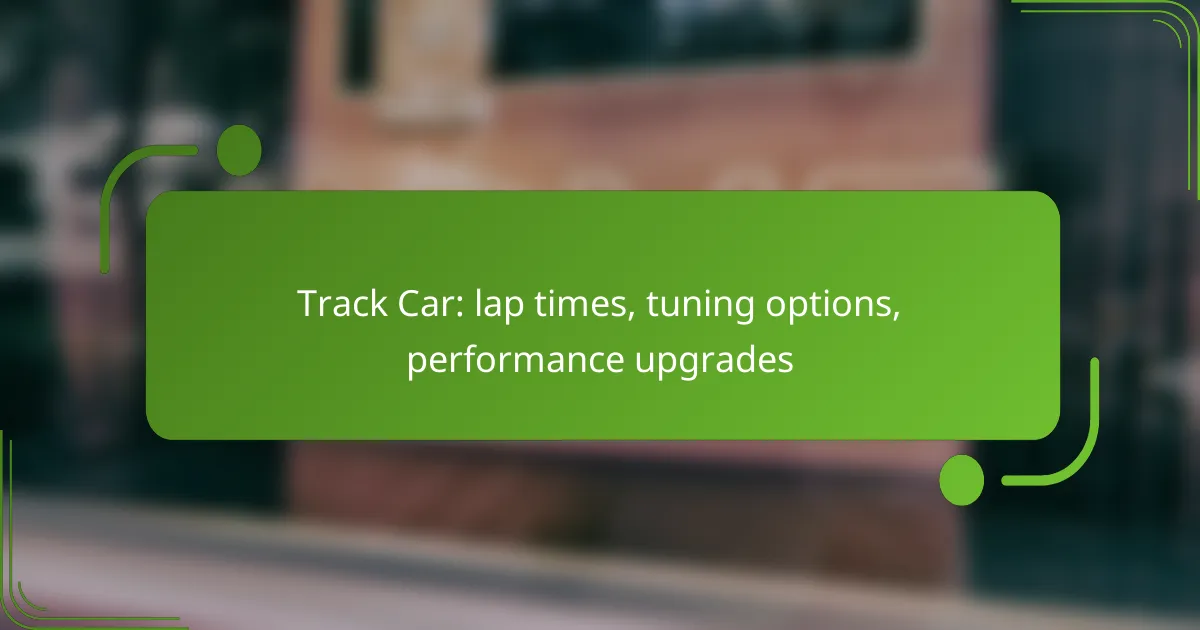Tracking car lap times is essential for performance enthusiasts looking to improve their skills and vehicle capabilities. By utilizing tools like GPS-based timers and mobile apps, drivers can accurately monitor their progress on the track. Additionally, tuning options and performance upgrades, such as ECU remapping and high-performance tires, play a crucial role in enhancing speed, handling, and overall efficiency, ultimately leading to faster lap times.

How to track car lap times in Canada?
To track car lap times in Canada, you can utilize various methods such as GPS-based lap timers, mobile apps, and trackside timing systems. Each option has its own advantages and considerations, allowing drivers to choose the best fit for their needs and budget.
Using GPS-based lap timers
GPS-based lap timers are devices that use satellite signals to measure your car’s speed and lap times accurately. These timers can provide real-time data and are often portable, making them easy to use at different tracks across Canada.
When selecting a GPS lap timer, consider factors such as accuracy, battery life, and ease of use. Many models offer features like lap comparison and data logging, which can help you analyze performance over time. Popular options include the RaceChrono and the Garmin Catalyst.
Mobile apps for lap timing
Mobile apps for lap timing are convenient tools that can turn your smartphone into a lap timer. Apps like Harry’s LapTimer and TrackAddict use your phone’s GPS to track lap times and provide additional metrics like speed and acceleration.
While using mobile apps, ensure that your phone has a reliable GPS signal and sufficient battery life for the duration of your track session. Many apps offer customizable settings, allowing you to tailor the experience to your specific needs. Check for compatibility with your device before downloading.
Trackside timing systems
Trackside timing systems are professional setups used at racing events to provide precise lap times. These systems often include transponders that attach to your car, allowing for accurate timing as you complete laps.
Using trackside timing systems typically requires registration with the track and may involve fees. These systems are ideal for competitive racing, as they provide highly accurate data and often include features like live timing displays for spectators. Be sure to check with the track for specific requirements and costs associated with their timing services.

What are the best tuning options for performance cars?
The best tuning options for performance cars focus on enhancing engine output, improving handling, and increasing overall efficiency. Key upgrades include ECU remapping, aftermarket exhaust systems, and suspension enhancements, each offering distinct benefits and considerations.
ECU remapping services
ECU remapping involves modifying the car’s engine control unit to optimize performance parameters. This can lead to significant gains in horsepower and torque, often ranging from 10% to 30%, depending on the vehicle and modifications. It’s essential to choose a reputable service provider to ensure the remap is tailored to your specific setup.
When considering ECU remapping, check for compatibility with your vehicle’s existing components and any potential warranty implications. Some remapping services also offer a return to stock option, allowing you to revert to the original settings if needed.
Aftermarket exhaust systems
Upgrading to an aftermarket exhaust system can improve engine efficiency and sound, while also potentially increasing power output. These systems typically reduce back pressure and enhance airflow, which can result in gains of around 5% to 15% in horsepower.
When selecting an exhaust system, consider the material (stainless steel is durable), design (cat-back systems are popular), and sound level. Ensure the system complies with local noise regulations to avoid legal issues.
Suspension upgrades
Suspension upgrades enhance a car’s handling and stability, crucial for track performance. Options include coilovers, sway bars, and upgraded shocks, which can significantly improve cornering and overall ride quality. Depending on the setup, these upgrades can reduce body roll and improve grip by 10% to 20%.
When upgrading suspension, consider your driving style and the type of tracks you frequent. A stiffer setup may offer better performance on smooth tracks but could compromise comfort on rough surfaces. Always align your suspension after installation to ensure optimal performance.

What performance upgrades improve lap times?
Performance upgrades that enhance lap times typically focus on improving grip, reducing weight, and increasing braking efficiency. Key upgrades include high-performance tires, lightweight racing wheels, and enhanced brake systems, each contributing to better handling and faster cornering speeds.
High-performance tires
High-performance tires are designed to provide superior grip and handling, especially in dry conditions. They often feature softer rubber compounds and specialized tread patterns that enhance traction during acceleration and cornering.
When selecting tires, consider the type of track you’ll be racing on. For example, slick tires are ideal for dry circuits, while tires with grooves may be better for mixed conditions. Brands like Michelin and Pirelli offer options that cater to various performance needs.
Lightweight racing wheels
Lightweight racing wheels reduce unsprung weight, which can significantly improve acceleration, braking, and handling. By choosing wheels made from materials like forged aluminum or carbon fiber, you can enhance your car’s responsiveness on the track.
When upgrading wheels, ensure they fit your vehicle’s specifications and consider the trade-off between weight and durability. A common range for racing wheels is between 6 to 10 kg per wheel, depending on the size and material.
Brake system enhancements
Enhancing your brake system can lead to shorter stopping distances and improved control during high-speed maneuvers. Upgrades may include larger brake discs, high-performance calipers, and specialized brake pads designed for track use.
Consider using a brake fluid with a higher boiling point to prevent fade during intense racing. Brands like Brembo and Wilwood offer comprehensive kits that can significantly boost braking performance. Regular maintenance and inspection of the brake system are crucial to ensure optimal performance on the track.

What factors affect car tuning decisions?
Car tuning decisions are influenced by various factors including driving style, the type of racing events, and budget constraints. Understanding these elements helps in making informed choices that enhance performance and meet specific racing goals.
Driving style considerations
Your driving style significantly impacts car tuning. Aggressive drivers may benefit from stiffer suspension and quicker steering response, while smoother drivers might prefer a more balanced setup for better control. Tailoring the tuning to your style can improve lap times and overall performance.
For example, if you frequently take sharp turns, optimizing your car’s handling characteristics will be crucial. Consider adjusting the camber angles and tire pressures to suit your cornering techniques.
Type of racing events
The type of racing event dictates specific tuning requirements. Track racing often demands high-speed stability and cornering grip, while drag racing focuses on acceleration and straight-line performance. Each discipline has unique needs that should guide your tuning decisions.
For instance, if participating in circuit racing, prioritize upgrades like brake systems and suspension tuning. Conversely, for drag racing, enhancements to the engine and transmission will be more critical to achieve faster quarter-mile times.
Budget constraints
Budget constraints play a vital role in car tuning decisions. It’s essential to balance performance upgrades with financial limitations to avoid overspending. Prioritize modifications that offer the best performance-to-cost ratio.
Consider starting with basic upgrades like performance tires and a cold air intake, which can provide noticeable improvements without a hefty investment. As funds allow, you can explore more advanced options like ECU tuning or suspension upgrades.

How to choose the right performance upgrades?
Choosing the right performance upgrades for your track car involves assessing compatibility with your current setup, considering brand reputation, and analyzing cost versus performance. Prioritize upgrades that enhance your car’s strengths while fitting within your budget and goals.
Compatibility with existing setup
Ensure that any performance upgrades you consider are compatible with your car’s existing components. For instance, if you have a specific engine type, check that the upgrades are designed for that engine to avoid issues with installation or performance.
Additionally, consider how upgrades will interact with each other. For example, a new exhaust system may require a corresponding tuning adjustment to maximize its benefits. Always consult with professionals or trusted sources to confirm compatibility.
Brand reputation and reviews
Researching brand reputation is crucial when selecting performance upgrades. Established brands often have a track record of reliability and performance, which can save you from costly mistakes. Look for brands that specialize in your vehicle type or performance category.
Reading reviews from other users can provide insights into the effectiveness and durability of the upgrades. Websites, forums, and social media can be valuable resources for gathering feedback and making informed decisions.
Cost vs. performance analysis
Conducting a cost versus performance analysis helps you determine the best value for your investment. Start by setting a budget and identifying upgrades that offer the most significant performance improvements within that range. For example, a suspension upgrade may provide better handling for a relatively modest cost compared to more expensive engine modifications.
Consider the long-term benefits of each upgrade. Sometimes, spending a bit more upfront on high-quality parts can lead to better performance and longevity, ultimately saving you money on repairs and replacements. Create a list of potential upgrades and rank them based on their performance gains relative to their costs.

What are the leading brands for car tuning in Canada?
The leading brands for car tuning in Canada include APR, Koni, and HRE Wheels, each specializing in different performance enhancements. These brands are well-regarded for their quality and effectiveness in improving vehicle performance, handling, and aesthetics.
APR for ECU tuning
APR is a prominent brand known for its ECU tuning solutions, which optimize engine performance by adjusting fuel maps, ignition timing, and boost levels. This tuning can lead to significant power gains, often in the range of 20-30% depending on the vehicle model and modifications.
When considering APR for ECU tuning, evaluate your vehicle’s current setup and intended use. It’s crucial to ensure that supporting modifications, such as upgraded exhaust systems or intercoolers, are in place to maximize the benefits of the tuning.
Koni for suspension upgrades
Koni specializes in suspension upgrades, offering adjustable shock absorbers that enhance handling and ride quality. Their products are designed to improve cornering stability and reduce body roll, making them ideal for track enthusiasts.
When selecting Koni suspension components, consider your driving style and the specific demands of the tracks you frequent. Adjustable options allow for fine-tuning, but installation should be performed by a professional to ensure optimal performance and safety.
HRE Wheels for performance wheels
HRE Wheels is renowned for manufacturing high-performance wheels that combine lightweight construction with strength. Their wheels are designed to reduce unsprung weight, which can improve acceleration, braking, and overall handling on the track.
When choosing HRE Wheels, consider the size and offset that best suits your vehicle’s specifications and intended use. It’s essential to balance aesthetics with performance, ensuring that the wheels fit properly and do not compromise the vehicle’s handling characteristics.
